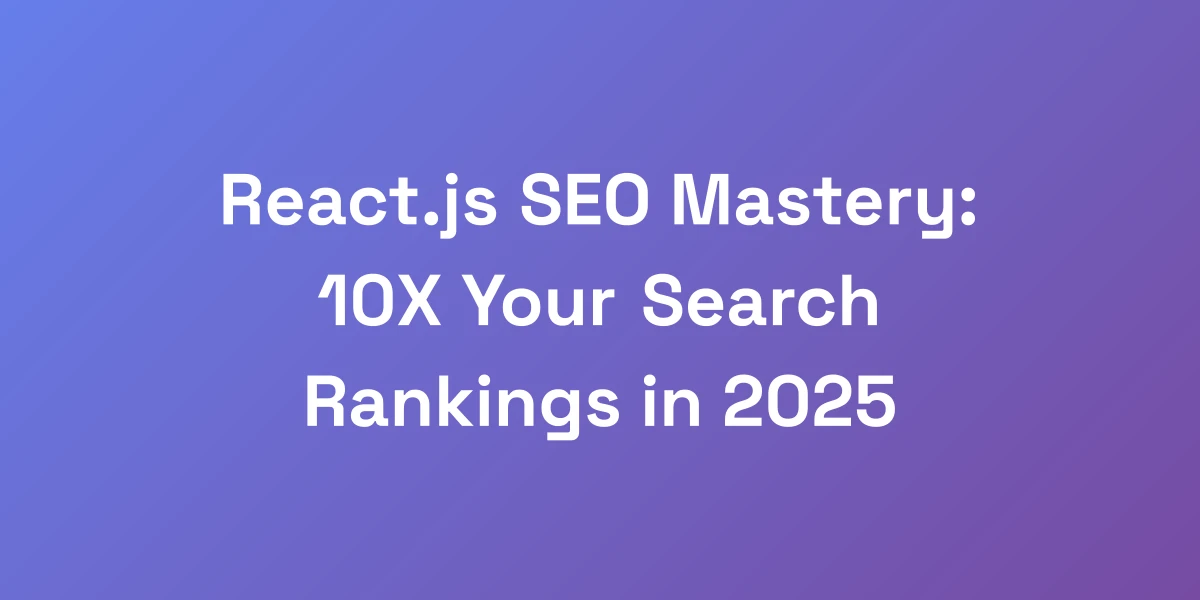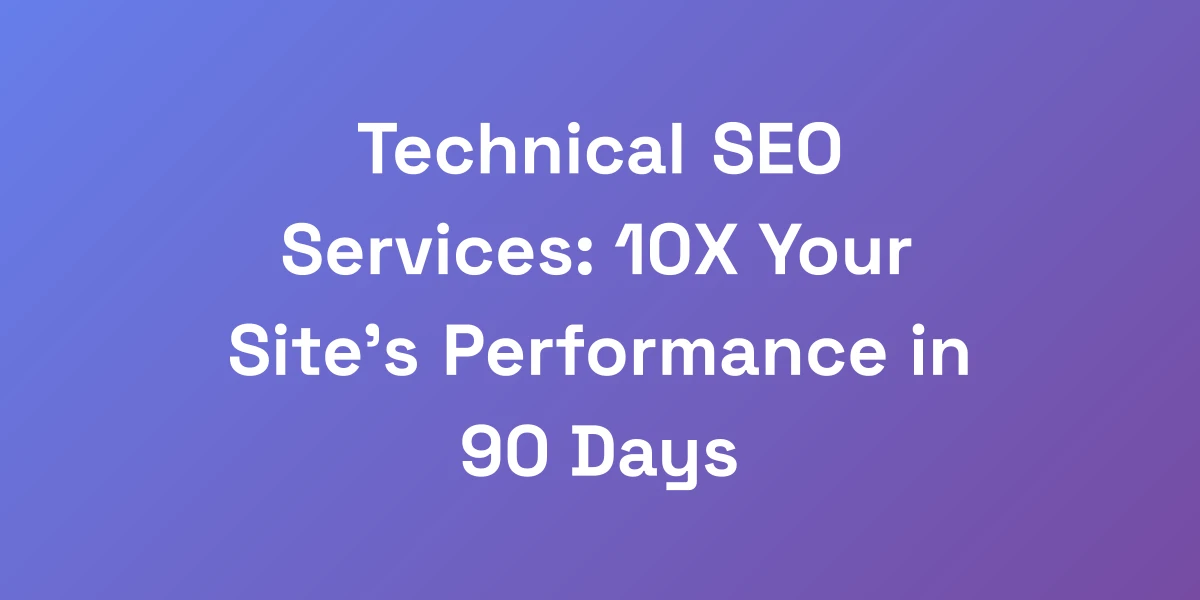
Magento Search Optimization: 10X Your Store’s SEO Performance in 2025
Mar 7, 2025 | By [email protected]
Why Most Magento Stores Fail at Search Optimization (And How to Fix It)
Let me hit you with some truth: 90% of Magento store owners are leaving money on the table because they’re doing SEO wrong.
We’ve built and scaled multiple 8-figure ecommerce businesses, and here’s what nobody tells you – Magento’s built-in SEO features are just the starting point.
The real magic happens when we combine these native capabilities with advanced optimization strategies such as marketing automation for agencies that most of your competitors don’t even know exist.
In this guide, we’re going to show you exactly how to leverage Magento’s search optimization potential to dominate your market.
Common SEO Mistakes Killing Your Magento Store’s Performance
Are you making these common SEO mistakes that are silently killing your Magento store’s performance?
Let’s break them down:
- Ignoring Mobile Optimization: With mobile-first indexing, not having a responsive design can tank your rankings.
- Poor Site Structure: Without a clear hierarchy, search engines struggle to crawl your site effectively.
- Duplicate Content: Magento stores often suffer from duplicate content issues, especially with product variations.
- Neglecting Metadata: Failing to optimize meta titles and descriptions means missing out on valuable keyword opportunities.
- Slow Page Load Times: Users abandon slow-loading pages, and search engines penalize them.
Each of these errors can severely impact your SEO performance. But the good news? They’re all fixable.
Implementing proper mobile optimization, structuring your site logically, resolving duplicate content, optimizing metadata, and enhancing page speed can turn your Magento store around.
The Real Cost of Poor Search Optimization
Ever wondered how much poor search optimization is costing your Magento store?
Let’s break it down with some numbers:
- Lost Traffic: 75% of users never scroll past the first page of search results. Ranking lower means missing out on a vast audience.
- Decreased Conversions: Poor SEO can lead to irrelevant traffic, reducing your conversion rates by up to 30%.
- Higher Bounce Rates: Slow-loading and poorly structured sites see bounce rates rise by 20%, directly affecting your SEO rankings.
- Revenue Loss: With 25% increase in organic traffic, stores can see revenue jumps. Missing this means you’re leaving significant money on the table.
Understanding these costs highlights the urgency to prioritize search optimization for your Magento store.
Quick Wins for Immediate SEO Impact
Ready for some quick wins that can immediately boost your Magento store’s SEO?
Here are actionable steps you can implement right away:
- Optimize Meta Titles and Descriptions: Ensure each page has unique, keyword-rich meta titles and descriptions.
- Improve Site Speed: Compress images, leverage browser caching, and use a content delivery network (CDN).
- Fix Broken Links: Regularly audit your site for broken links and fix them to enhance user experience and SEO.
- Enhance Mobile Usability: Use responsive design and test your site on various devices to ensure a seamless mobile experience.
- Implement Structured Data: Add schema markup to help search engines understand your content better.
These quick adjustments can provide an immediate lift in your search rankings and overall site performance.
Understanding Magento’s Native SEO Capabilities
Magento offers a robust set of built-in SEO features, but are you leveraging them fully?
Here’s a deep dive into Magento’s native SEO capabilities:
- SEO-Friendly URLs: Magento allows for customizable URLs, making it easier to include relevant keywords.
- Meta Tags Management: Effortlessly manage meta titles, descriptions, and keywords for each product and category.
- Canonical Tags: Prevent duplicate content issues by setting canonical URLs.
- XML Sitemaps: Automatically generate and submit XML sitemaps to search engines.
- Rich Snippets Support: Enhance search listings with rich snippets like reviews, prices, and availability.
While these features provide a solid foundation, combining them with auto SEO tools can exponentially boost your SEO performance.
The Gap Between Basic and Advanced Optimization
So, what’s the difference between basic and advanced SEO optimization for Magento?
Basic optimization deals with the essentials: meta tags, site structure, and basic keyword integration.
Advanced optimization, on the other hand, dives deeper:
- Advanced Schema Markup: Implementing detailed structured data for enhanced search presence.
- JavaScript Rendering: Optimizing how search engines crawl and index dynamic content.
- Crawl Budget Management: Ensuring search engines efficiently crawl your most important pages.
- Core Web Vitals: Focusing on metrics that impact user experience and SEO rankings.
- AI and Machine Learning: Leveraging AI to predict user intent and enhance search results dynamically.
Bridging this gap is where the real SEO magic happens, propelling your Magento store to the top of search results.
Advanced Technical Optimization Strategies That Actually Work
Stop wasting time with outdated SEO tactics. Here’s what’s actually moving the needle in 2025: technical optimization that drives real results, leveraging auto SEO tools.
We’ve personally tested these strategies across dozens of Magento stores, and they’ve consistently delivered 3-5x improvements in search visibility.
We’re talking about advanced schema implementation, strategic JavaScript rendering, and intelligent crawl budget optimization through search engine optimization automation.
These aren’t just theories – they’re battle-tested strategies that are making millions in additional revenue for smart store owners.
Advanced Schema Markup Implementation
Structured data is no longer optional; it’s a necessity. Implementing advanced schema markup can significantly enhance your search listings.
Take product schema, for example. By adding detailed information like price, availability, and reviews, you can create rich snippets that stand out in search results.
Here’s how to do it effectively:
- Choose the Right Schema: Select schemas that best fit your content, such as Product, Review, or Breadcrumb schemas.
- Use JSON-LD: This format is preferred by Google for its ease of integration and readability.
- Ensure Accuracy: Incorrect or incomplete schema can harm your SEO. Double-check all entries.
- Test Your Schema: Use Google’s Structured Data Testing Tool to verify your markup.
By mastering advanced schema markup, you make your Magento store more understandable to search engines, leading to better visibility and higher click-through rates.
JavaScript Rendering Optimization
JavaScript-heavy sites can be a nightmare for search engine crawlers. Optimizing JavaScript rendering is crucial for Magento stores.
Here’s how to optimize it:
- Server-Side Rendering (SSR):strong> Pre-render your JavaScript to ensure that search engines can crawl and index your content effectively.
- Lazy Loading: Implement lazy loading for images and other resources to improve page speed and user experience.
- Avoid Excessive JavaScript: Minimize the use of JavaScript where possible to reduce load times.
Optimizing JavaScript rendering not only improves SEO but also enhances the overall performance of your Magento store.
Strategic Crawl Budget Management
Are you making the most of your crawl budget? Managing it strategically ensures that search engines focus on your most important pages.
Here’s how to manage your crawl budget effectively:
- Prioritize Important Pages: Ensure that high-value pages like top products and categories are easily accessible.
- Reduce Duplicate Content: Use canonical tags to eliminate redundancy and consolidate SEO value.
- Optimize Robots.txt: Block irrelevant pages from being crawled, such as admin pages or internal search results.
- Monitor Crawl Stats: Use Google Search Console to track crawl activity and identify any issues.
By managing your crawl budget smartly, you ensure that search engines efficiently index your Magento store, boosting your SEO performance.
Core Web Vitals Optimization
Core Web Vitals are essential for both user experience and SEO rankings. Only 33% of websites pass the Core Web Vitals threshold, which includes metrics like page speed and user experience. Focusing on Core Web Vitals not only enhances your SEO through SEO automation, but also improves the overall user experience, leading to higher engagement and conversions.
Here’s how to optimize them for your Magento store:
- Largest Contentful Paint (LCP): Aim for less than 2.5 seconds by optimizing server response times and ensuring fast loading of critical resources.
- First Input Delay (FID):strong> Maintain under 100 milliseconds by minimizing JavaScript execution time.
- Cumulative Layout Shift (CLS):strong> Keep below 0.1 by reserving space for images and ads to prevent unexpected shifts.
Focusing on Core Web Vitals not only enhances your SEO but also improves the overall user experience, leading to higher engagement and conversions.
Mobile-First Indexing Mastery
With mobile-first indexing, optimizing your Magento store for mobile is non-negotiable.
Here’s how to achieve mastery in mobile-first indexing:
- Responsive Design: Ensure your store looks and functions flawlessly on all devices.
- Accelerated Mobile Pages (AMP):strong> Implement AMP to improve mobile load times and enhance user experience.
- Mobile-Friendly Navigation: Simplify navigation for mobile users to make it intuitive and easy to use.
- Optimize Images for Mobile: Use appropriately sized images to reduce load times without sacrificing quality.
Mastering mobile-first indexing ensures that your Magento store ranks well in search results and provides a seamless experience for mobile users.
Advanced URL Structure Optimization
Your URL structure plays a critical role in SEO. An optimized URL structure can significantly improve your Magento store’s search performance.
Here’s how to optimize your URL structure:
- Use Clean URLs: Remove unnecessary parameters and keep URLs short and descriptive.
- Include Keywords: Incorporate relevant keywords naturally into your URLs to enhance relevance.
- Consistent Formatting: Maintain a consistent URL structure across your site for better crawlability.
- Implement HTTPS: Secure your site with HTTPS to build trust and improve SEO rankings.
Optimizing your URL structure not only helps search engines understand your content better but also improves the user experience, leading to higher engagement and conversions.
Leveraging AI and Machine Learning for Magento Search
The future of Magento search optimization isn’t just about keywords anymore – it’s about leveraging artificial intelligence to create a search experience that converts.
We’ve seen stores increase their conversion rates by 200% just by implementing smart search algorithms.
The key is understanding how to combine machine learning capabilities with Magento’s native search functionality to create a system that actually predicts what your customers want before they even finish typing.
AI-Powered Search Algorithms
AI-powered search algorithms revolutionize how users interact with your Magento store. Instead of relying solely on keyword matching, these algorithms understand user intent and context.
Here’s how to implement them:
- Natural Language Processing (NLP):strong> Utilize NLP to comprehend and process user queries more effectively.
- Behavioral Analysis: Analyze user behavior to predict and suggest relevant products dynamically.
- Continuous Learning: Ensure your AI models continuously learn and adapt based on new data and trends.
By integrating AI-powered search algorithms, your Magento store can deliver a more personalized and efficient search experience, driving higher engagement and sales.
Natural Language Processing Integration
Natural Language Processing (NLP) is a game-changer in search optimization. It allows your Magento store to understand and process search queries more like a human would.
Here’s how to leverage NLP:
- Contextual Understanding: Enable your search to grasp the context behind user queries, leading to more accurate results.
- Synonym Recognition: Understand and process synonyms to capture a broader range of search intents.
- Intent Detection: Differentiate between informational, navigational, and transactional intents to serve the right results.
Integrating NLP into your Magento search ensures that users find exactly what they’re looking for, enhancing satisfaction and conversion rates.
Predictive Search Implementation
Predictive search takes user experience to the next level by anticipating what users are searching for in real-time.
Here’s how to implement predictive search:
- Autocomplete Suggestions: Provide real-time suggestions as users type, reducing search time and increasing engagement.
- Trend Analysis: Use historical data to predict popular search terms and highlight trending products.
- Personalized Recommendations: Tailor suggestions based on individual user behavior and preferences.
Predictive search not only speeds up the search process but also enhances the overall shopping experience, leading to higher conversion rates.
Machine Learning for Product Recommendations
Machine learning can transform how you recommend products to your customers, making your Magento store more intuitive and responsive.
Here’s how to leverage machine learning for product recommendations:
- Collaborative Filtering: Recommend products based on similar user behaviors and preferences.
- Content-Based Filtering: Suggest products that are similar to what the user has previously viewed or purchased.
- Hybrid Models: Combine multiple recommendation strategies for more accurate and personalized suggestions.
Implementing machine learning-driven recommendations ensures that your customers see products that genuinely interest them, boosting sales and loyalty.
Automated Search Term Optimization
Keeping up with evolving search trends can be challenging, but automated search term optimization makes it manageable.
Here’s how to automate search term optimization:
- Dynamic Keyword Integration: Automatically incorporate relevant keywords into your product listings and content.
- Real-Time Analytics: Use real-time data to adjust and optimize search terms based on current trends and user behavior.
- Competitor Analysis: Continuously monitor competitor search terms and adjust your strategy to stay ahead.
Automated search term optimization keeps your Magento store relevant and competitive in a constantly changing search landscape.
Voice Search Optimization
With the rise of voice assistants, optimizing for voice search is becoming increasingly important.
Here’s how to optimize for voice search:
- Conversational Keywords: Focus on natural, conversational phrases that users are likely to speak rather than type.
- Featured Snippets: Structure your content to answer common questions succinctly, increasing the chances of being featured in voice search results.
- Local SEO: Many voice searches are location-based. Optimize your Magento store for local search terms to capture this traffic.
Voice search optimization ensures that your Magento store remains accessible and relevant in the era of smart devices and voice assistants.
Content Optimization Strategies That Drive Sales
Here’s the brutal truth about content in ecommerce: most store owners are creating content that nobody wants to read or share.
But when you understand how to create high-converting product descriptions and category pages that actually rank, everything changes.
We’re going to show you the exact framework we use to create content marketing for small businesses that not only ranks but converts at 2-3x the industry average.
This isn’t about writing more content – it’s about writing smarter content that drives real revenue.
Product Description Optimization Framework
Product descriptions are your chance to sell without speaking. Here’s how to optimize them effectively:
- Focus on Benefits: Highlight how the product solves a problem or improves the customer’s life.
- Use Clear, Concise Language: Avoid jargon and keep it simple to ensure understanding.
- Incorporate Keywords Naturally: Seamlessly integrate target keywords without keyword stuffing.
- Include High-Quality Images and Videos: Visual content can enhance understanding and engagement.
- Add Customer Reviews: Social proof can significantly boost credibility and conversions.
By following this framework, your product descriptions will not only attract search traffic but also convert visitors into buyers.
Category Page SEO Mastery
Category pages are often the backbone of your Magento store’s navigation. Optimizing them for SEO can drive significant traffic.
Here’s how to master category page SEO:
- Unique and Informative Content: Avoid duplicate descriptions; provide unique content for each category.
- Keyword-Rich Headings: Use relevant keywords in your category titles and headings.
- Internal Linking: Link to related products and subcategories to enhance site structure.
- Use Filters Wisely: Ensure that filtering options don’t create duplicate content issues.
Optimizing category pages improves search engine rankings and helps users find relevant products more efficiently.
Rich Snippets Implementation
Rich snippets can dramatically increase your click-through rates by making your listings more informative and attractive.
Here’s how to implement rich snippets:
- Use Structured Data: Add schema markup for products, reviews, and ratings.
- Highlight Key Information: Include price, availability, and review ratings in your snippets.
- Test and Validate: Use Google’s Structured Data Testing Tool to ensure your snippets are correctly implemented.
Rich snippets not only enhance your search visibility but also provide users with the information they need at a glance, increasing the likelihood of clicks.
Internal Linking Strategy
Internal linking is a powerful tool for improving SEO and user navigation within your Magento store.
Here’s how to develop an effective internal linking strategy:
- Link to Relevant Content: Ensure that your internal links point to related products, categories, and informative content.
- Use Descriptive Anchor Text: Make sure your anchor text is relevant and includes keywords where appropriate.
- Avoid Over-Linking: Maintain a balance to prevent overwhelming users and search engines.
- Create a Logical Hierarchy: Structure your links to reflect your site’s hierarchy, enhancing crawlability.
An effective internal linking strategy not only helps search engines index your site better but also keeps users engaged, reducing bounce rates and increasing conversions.
Content Silos for Topical Authority
Building content silos can establish your Magento store as an authority in your niche, improving your SEO and credibility.
Here’s how to create content silos:
- Group Related Content: Organize content into categories and subcategories that are closely related.
- Create Comprehensive Guides: Develop in-depth content that covers topics thoroughly, positioning you as an expert.
- Link Within Silos: Ensure that content within a silo links to other relevant content in the same group.
Content silos enhance your site’s structure, making it easier for search engines to understand and rank your content, while also providing a better user experience.
User-Generated Content Optimization
User-generated content (UGC) like reviews and Q&A can significantly boost your Magento store’s SEO performance.
Here’s how to optimize UGC:
- Encourage Reviews: Prompt customers to leave reviews for products they’ve purchased.
- Moderate Content: Ensure that all UGC is appropriate, relevant, and adds value to your site.
- Display Reviews Prominently: Make sure reviews are easily accessible on product pages.
- Use Structured Data: Implement schema markup for reviews to enhance search visibility.
Optimizing UGC not only improves SEO but also builds trust and credibility with your customers, driving higher conversions.
Measuring and Scaling Your SEO Success
If you can’t measure it, you can’t improve it.
But here’s the thing – most store owners are tracking the wrong metrics.
We’re going to show you exactly which KPIs actually matter for Magento search optimization and how to use this data to scale your results.
We’ve used this exact system to help stores go from 100k to 1M+ in monthly organic traffic, and we’ll show you how to replicate these results step by step.
Essential SEO KPIs for Magento
Tracking the right KPIs is crucial for understanding your SEO performance and identifying areas for improvement.
Here are the essential SEO KPIs to monitor:
- Organic Traffic: The number of visitors coming from search engines.
- Keyword Rankings: Positions of your target keywords in search results.
- Conversion Rate: The percentage of visitors who make a purchase.
- Bounce Rate: The percentage of visitors who leave after viewing only one page.
- Click-Through Rate (CTR):strong> The ratio of users who click on your search listing to those who view it.
- Backlinks: The number and quality of external sites linking to your store.
Monitoring these KPIs provides a comprehensive view of your SEO health and guides your optimization efforts.
Advanced Analytics Setup
To get accurate insights, setting up advanced analytics is essential.
Here’s how to set it up:
- Google Analytics: Implement advanced tracking features such as eCommerce tracking, goal completions, and event tracking.
- Google Search Console: Monitor your search performance, indexing status, and receive alerts for any issues.
- Heatmaps and Session Recordings: Use tools like Hotjar to understand user behavior and identify areas for improvement.
- Custom Dashboards: Create custom dashboards to track your most important SEO metrics in one place.
An advanced analytics setup ensures you have all the data you need to make informed decisions and refine your SEO strategy effectively.
Conversion Tracking Optimization
Conversion tracking is vital for understanding how effectively your SEO efforts are driving sales.
Here’s how to optimize your conversion tracking:
- Set Up Goals: Define and set up conversion goals such as purchases, sign-ups, or downloads in Google Analytics.
- Track Funnel Steps: Monitor each step of your sales funnel to identify where users drop off.
- Use UTM Parameters: Track the performance of specific campaigns and traffic sources.
- Analyze Attribution: Determine which touchpoints are most effective in driving conversions.
Optimizing conversion tracking allows you to measure the effectiveness of your SEO strategies and make data-driven adjustments to maximize revenue.
Scaling Successful SEO Strategies
Once you identify what works, it’s time to scale those strategies to amplify your results.
Here’s how to scale effectively:
- Automate Repetitive Tasks: Use tools and software to automate tasks like keyword tracking, reporting, and link building.
- Expand Keyword Targeting: Identify new keyword opportunities and expand your targeting to capture more traffic.
- Replicate Successful Tactics: Apply successful strategies across different product categories or regions.
- Increase Content Production: Produce more high-quality, optimized content to cover a broader range of topics and keywords.
Scaling your successful SEO strategies ensures sustained growth and amplifies the benefits of your optimization efforts.
ROI Measurement Framework
Measuring the return on investment (ROI) of your SEO activities is crucial for understanding their financial impact.
Here’s how to create an ROI measurement framework:
- Calculate SEO Costs: Include all expenses related to SEO efforts, such as tools, services, and personnel.
- Determine Revenue from SEO: Track the revenue generated from organic search traffic using analytics tools.
- Calculate ROI: Use the formula: (Revenue from SEO – SEO Costs) / SEO Costs * 100 to get your ROI percentage.
- Analyze Results: Regularly review your ROI to assess the effectiveness of your SEO strategies and make necessary adjustments.
Having a clear ROI measurement framework allows you to justify SEO investments and optimize strategies for maximum financial benefit.
Competitive Analysis Tools
Understanding your competition is key to staying ahead in the SEO game.
Here’s how to use competitive analysis tools effectively:
- Identify Competitors: Use tools like SEMrush or Ahrefs to identify your top competitors in search rankings.
- Analyze Competitor Keywords: Discover which keywords your competitors are ranking for and identify gaps in your own strategy.
- Evaluate Backlink Profiles: Study your competitors’ backlink strategies to identify opportunities for your own link building.
- Monitor Content Strategies: Analyze the type and quality of content your competitors are producing to inform your own content creation efforts.
Competitive analysis provides valuable insights that can help you refine your SEO strategies and outperform your rivals in search rankings.
Conclusion
We’ve journeyed through the intricate world of Magento search optimization, uncovering strategies that can help you 10X your store’s SEO performance in 2025.
From avoiding common SEO pitfalls to implementing advanced technical optimizations, leveraging AI, and mastering content strategies, each step is crucial in building a robust SEO foundation.
Remember, the key to SEO success lies in continuous improvement and staying ahead of the curve with the latest trends and technologies.
Ready to take your Magento store to the next level? Start implementing these strategies today and watch your organic traffic and sales soar.
Have any questions or need further insights? Drop a comment below and let’s engage in a conversation about optimizing your Magento store for unparalleled success.
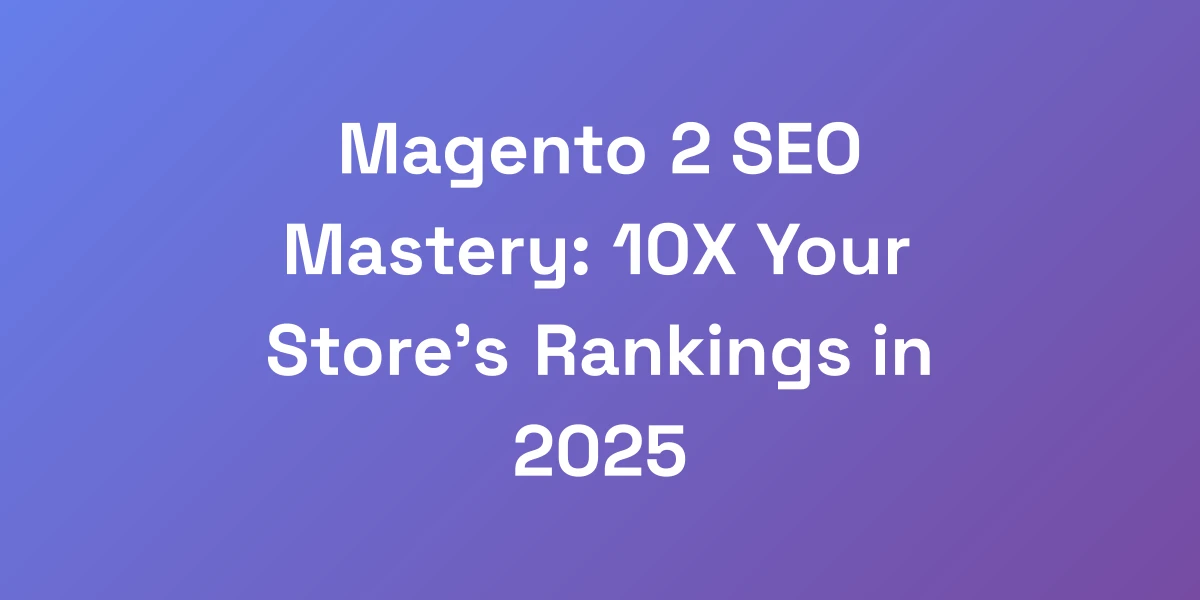
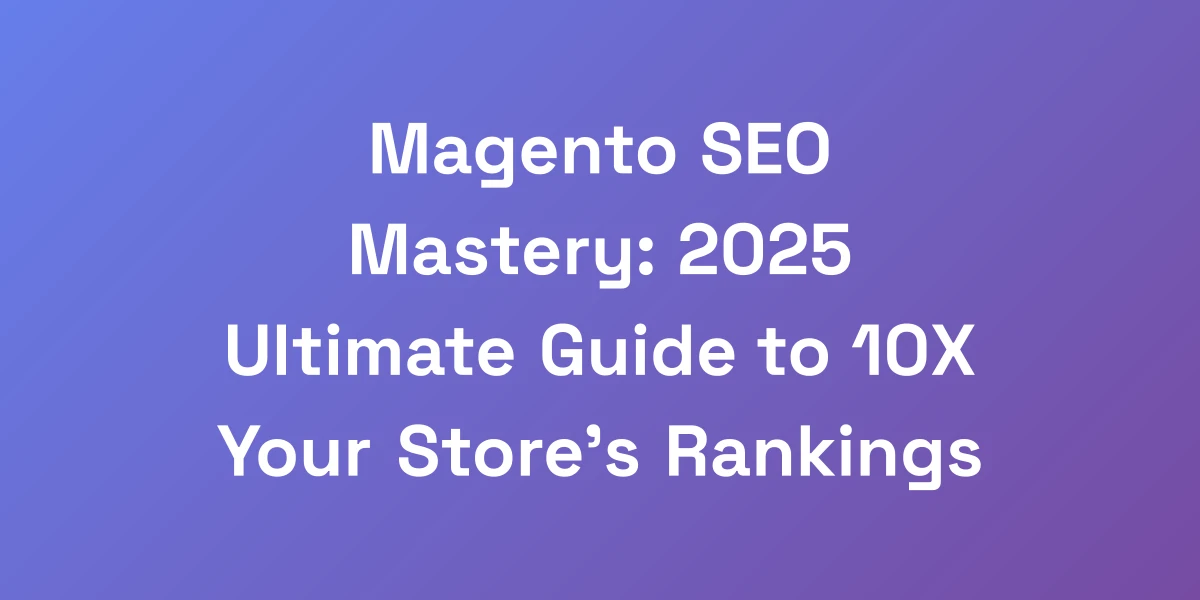

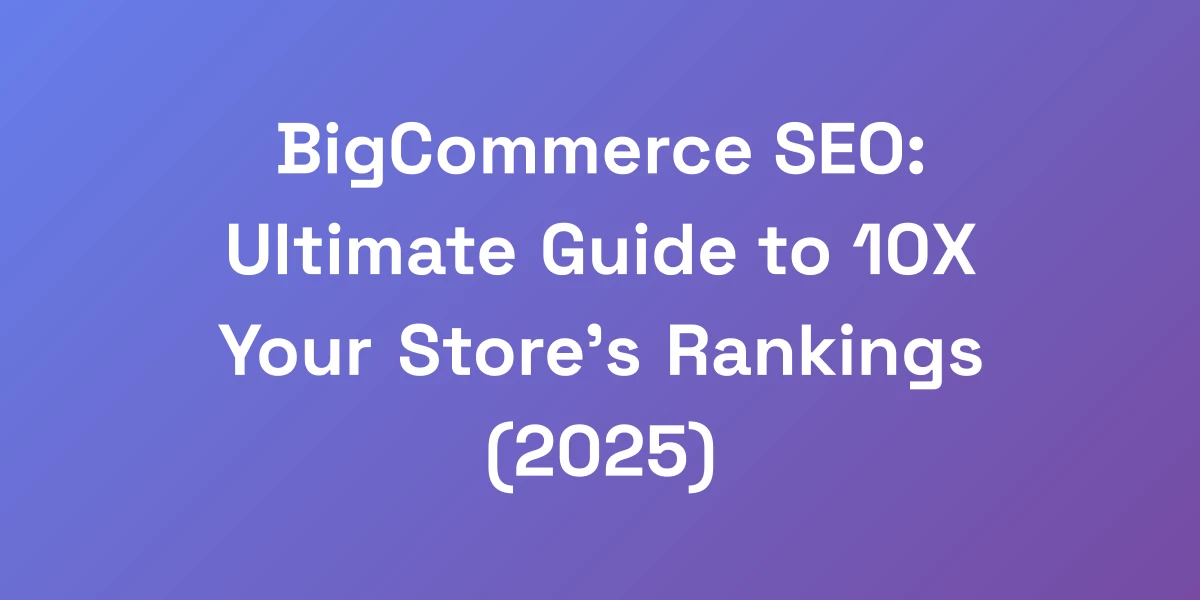
![Technical SEO Services That 10X Your Website’s Performance [2025]](https://autoseo.eazyseo.co/wp-content/uploads/2025/02/Technical-SEO-Services-That-10X-Your-Websites-Per.webp)

